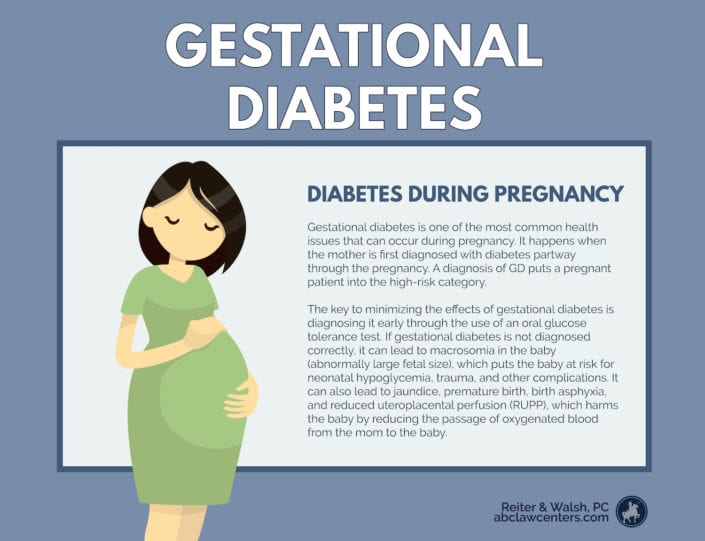Gestational Diabetes: Signs, Causes, and Risk Factors
Gestational diabetes is one of the most common health issues that can occur during pregnancy. It happens when the mother is diagnosed with diabetes for the first time while pregnant. The key to minimizing the effects of gestational diabetes is diagnosing it early. If gestational diabetes is misdiagnosed or not identified, it can lead to conditions that put the baby at risk for complications or trauma during delivery.

Gestational Diabetes
Signs and Symptoms
Gestational diabetes usually does not manifest in any obvious symptoms. However, blurred vision, fatigue, frequent infections, increased urination and thirst, and nausea may be signs and symptoms of gestational diabetes. Gestational diabetes can only be diagnosed through routine prenatal testing and screening.
What Causes Gestational Diabetes?
During pregnancy, the body produces a larger amount of certain hormones to help maintain a healthy pregnancy and provide nutrients to the baby. This increase in hormones can interfere with insulin, a substance which takes glucose (sugar) out of the bloodstream and uses it for energy. This causes higher blood sugar levels, which is normal in pregnancy because the extra glucose is needed to support the baby. But when the amount of insulin produced is less than what is needed to handle blood sugar levels, it can lead to high levels of glucose in the bloodstream (this is also known as hyperglycemia), and gestational diabetes can occur.
Risk Factors
Risk for gestational diabetes may increase if the patient has any of the following conditions:
- A previous diagnosis of gestational diabetes or prediabetes, poor impaired glucose tolerance, or impaired fasting glycemia
- A family history of type 2 diabetes
- Maternal obesity
- Advanced maternal age (over 35)
- Previously birthed a baby that weighed more than 9 pounds
- High blood pressure and preeclampsia
- Too much amniotic fluid (polyhydramnios)
- Significant weight gain before or during the first 18-24 weeks of pregnancy
- Medical conditions associated with risk for diabetes, such as polycystic ovary syndrome (PCOS)
Diagnosis
The American Congress of Obstetrics and Gynecologists (ACOG) recommends that all pregnant patients receive an oral glucose tolerance test between the 24th and 28th week of pregnancy. People who have risk factors for gestational diabetes may have this test earlier in the pregnancy, typically around the 18th week. Patients who develop pregnancy-related diabetes should also be re-tested 6-12 weeks after delivery.
To test for gestational diabetes, the patient will drink a syrupy solution and their blood will be tested to check glucose level an hour later. A follow-up test is then given where the patient fasts overnight and then has their blood sugar tested the next morning. After the second test, they will drink a solution that has an even higher level of glucose than the solution given during the initial test. The patient’s blood glucose level will then be checked every hour for a period of three hours. If at least two of the blood glucose readings are higher than normal, the patient will be diagnosed with gestational diabetes.
Treatment and Management
With gestational diabetes, frequent check-ups by the physician are essential, especially during the last three months of pregnancy, and especially if the patient has other factors that make them a high-risk pregnancy.
Once a patient is diagnosed with gestational diabetes, the physician will have them monitor their diabetes by testing their glucose levels at home. The most common way is to draw a drop of blood from a finger using a device that will give a glucose reading. The goals of treatment are to keep blood glucose levels within normal limits during the pregnancy and to make sure the growing baby is healthy.
In addition to close monitoring, it is recommended that mothers with gestational diabetes be treated with dietary counseling, oral hypoglycemic medications, or insulin.
Tell us your story.
Due to the multiple, serious complications that can arise from gestational diabetes, rigorous testing and monitoring is important. If your family is coping with a birth injury diagnosis for a child, our attorneys can help.


Get Legal Help
All pregnant patients must be screened for gestational diabetes. It is critical for physicians to accurately read the results of gestational diabetes tests in order to prescribe the correct treatment plan, and plan for a safe labor and delivery to avoid complications and injury to the baby.
If your child was diagnosed with a birth injury, and you suspect it’s from mismanaged gestational diabetes, our experienced birth injury lawyers at ABC Law Centers: Birth Injury Lawyers can help. Our firm has focused exclusively on birth injury for 25 years, and has handled cases for clients who had mismanaged gestational diabetes. To begin your free case review, you may contact us in any of the following ways below. Not only is the initial consultation free, but you will pay no fees unless we win your case.
Featured Videos
Posterior Position
Hypoxic-Ischemic Encephalopathy (HIE)

Featured Testimonial
What Our
Clients Say…
After the traumatic birth of my son, I was left confused, afraid, and seeking answers. We needed someone we could trust and depend on. ABC Law Centers: Birth Injury Lawyers was just that.
- Michael
Helpful resources
- Pregnancy Complications: Gestational Diabetes
- Gestational diabetes mellitus: Screening, diagnosis, and prevention
- Gestational diabetes mellitus: Glycemic control and maternal prognosis
- Gestational diabetes mellitus: Obstetric issues and management
- Hyperglycemia and adverse pregnancy outcomes
- Timing of Delivery in Gestational Diabetes Mellitus: Need for Person-Centered, Shared Decision-Making
- Large for gestational age newborn
- Infants of women with diabetes
- Unconjugated hyperbilirubinemia in term and late preterm infants: Management


